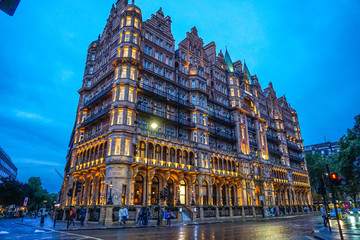UK Market Overview
The UK is one of the world's largest and most dynamic economies, with a GDP of over $3 trillion. London is a leading financial center and a key driver of the UK's economy. The real estate market in London is diverse and in high demand from both domestic and overseas investors. The UK's economy is growing at a steady rate of around 1.5% per year, driven by industries like financial services, technology, and creative sectors. Investment in the UK market offers stable returns with a supportive business environment and a highly skilled workforce.


The real estate market in London is a key driver of the UK economy, with high demand for residential and commercial properties from both domestic and overseas investors. The city has a diverse range of property types, from historic buildings and traditional townhouses to modern skyscrapers and luxury apartments.

Investment Sectors in the UK
Real Estate - The UK's real estate market is a key driver of the economy, particularly in London, which is one of the world's most important financial centers. The total value of the
Care Homes - There has been a growing demand for care homes in the UK due to an aging population. The care home market is expected to be worth £15.9 billion by 2025, with a projected annual growth rate of 5.5%. This presents significant opportunities for investment in the sector.
Hospitality Properties - This includes properties used for hospitality purposes, such as hotels and serviced apartments. In 2020, the total value of investment in UK hospitality properties was £1.1 billion, with the market experiencing a significant decline due to the impact of the pandemic.


Technology - The UK is home to some of the world's leading technology companies and has a highly skilled workforce in this sector. The UK's digital economy is expected to be worth £358 billion by 2025, with an annual growth rate of 7.2%.
Renewable Energy - The UK has committed to achieving net-zero carbon emissions by 2050, which has created significant opportunities for investment in renewable energy. The renewable energy sector is projected to be worth £80 billion by 2030, with a potential annual growth rate of 12%.
Infrastructure - The UK government has been investing heavily in infrastructure, with a focus on improving connectivity across the country. The National Infrastructure and Construction Pipeline outlines £600 billion worth of investment opportunities in areas such as transport, energy, and digital infrastructure.
Residential Properties
Residential real estate market valued at £7.3 trillion.
This includes both traditional and purpose-built rental housing, as well as student accommodation. The UK has a strong rental market and a growing population, which make residential investments attractive.

Overall, the UK Residential real estate market offers a diverse range of investment opportunities across different types of properties, each with its own unique characteristics and economic drivers.
Student Housing

This includes accommodation specifically designed for university students, including shared flats and studios. The number of international students in the UK is expected to increase by 15% over the next decade, creating demand for student accommodation. In 2020, the total value of investment in the UK student housing market was £6.5 billion.
Affordable Housing :

This includes properties that are rented or sold at below-market rates, typically to low-income or first-time buyers. The UK government has committed to investing £12.2 billion in affordable housing between 2021-2026. In 2020, there were 57,485 affordable homes completed in the UK.
According to a 2020 report by the National Housing Federation, there is a shortage of 3.8 million affordable homes in England alone. This has resulted in a growing demand for affordable housing across the country.
In 2020, the UK government announced an additional £12.2 billion in funding for affordable housing over the next five years, with a focus on delivering social rented homes and shared ownership properties.
Traditional Rental Housing
This includes houses, apartments, and flats that are rented out to tenants. The UK rental market is growing, with the proportion of households in the private rental sector increasing from 9% in 2002 to 20% in 2020. In 2021, the average monthly rent for a one-bedroom property in the UK was £800, while the average rent for a two-bedroom property was £1,000.
Purpose-Built Rental Housing

This includes new developments of properties specifically designed for rental purposes. The build-to-rent sector in the UK is growing, with the number of BTR homes under construction increasing by 47% in 2020. In 2021, the average rent for a build-to-rent apartment in the UK was £1,455 per month.
Care Homes
There has been a growing demand for care homes in the UK due to an aging population. The care home market is expected to be worth £15.9 billion by 2025, with a projected annual growth rate of 5.5%. This presents significant opportunities for investment in the sector.
The UK care home market is worth £15.9 billion, with approximately 18,000 care homes and 470,000 beds across the country.
The UK government has launched a range of policies and initiatives aimed at supporting the care home sector, including increased funding for social care and the implementation of new standards for care home providers.

Despite the impact of the pandemic, the UK care home sector is expected to remain a significant investment opportunity, driven by the growing demand for elderly care services and the increasing focus on providing high-quality care.
Overall, the UK care home sector presents a range of investment opportunities for investors, with the potential for long-term growth driven by demographic trends and government support.
Office Properties
This includes buildings used primarily for office purposes, such as headquarters, business centers, and co-working spaces. In 2020, the total value of investment in UK office properties was £10.6 billion, with London accounting for 65% of that total.

Retail Properties

This includes properties used primarily for retail purposes, such as shopping centers, high street shops, and supermarkets. In 2020, the total value of investment in UK retail properties was £2.2 billion, with out-of-town retail parks and supermarkets seeing increased demand due to the pandemic.
Industrial Properties

This includes properties used for manufacturing, distribution, and storage purposes, such as warehouses and logistics centers. In 2020, the total value of investment in UK industrial properties was £7.3 billion, with strong demand driven by the growth of e-commerce and online shopping.
Hospitality Properties

This includes properties used for hospitality purposes, such as hotels and serviced apartments. In 2020, the total value of investment in UK hospitality properties was £1.1 billion, with the market experiencing a significant decline due to the impact of the pandemic.
The UK hospitality sector is a significant contributor to the country's economy, generating £59.3 billion in gross value added (GVA) in 2019, according to a report by UK Hospitality.
The UK hospitality sector presents a range of investment opportunities, with potential for growth in areas such as sustainable tourism and technology-driven experiences.
This includes niche sectors such as data centers, student housing, and build-to-rent properties. These sectors can offer higher yields and long-term income streams.
Overall, the UK real estate market offers a wide range of investment opportunities across different sectors. Each sector has its own unique characteristics and growth prospects, making it important for investors to carefully consider their investment goals and risk tolerance when deciding where to invest.
